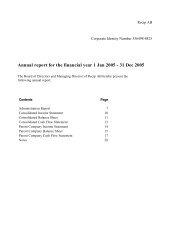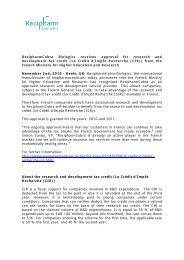Recipharm Annual Report 2006
Recipharm Annual Report 2006
Recipharm Annual Report 2006
Create successful ePaper yourself
Turn your PDF publications into a flip-book with our unique Google optimized e-Paper software.
SUPPLEMENTARY DISCLOSURES<br />
GENERAL DISCLOSURES<br />
Accounting principles<br />
The accounting principles applied are in accordance with the Swedish <strong>Annual</strong> Accounts Act and the general<br />
advice and guidelines of the Swedish Accounting Standards Board. Any deviations are specified in the notes<br />
below. The accounting principles remain unchanged compared with the previous year.<br />
Valuation principles, etc<br />
Assets, provisions and liabilities are valued at acquisition cost, unless otherwise stated below.<br />
Receivables<br />
Receivables are reported in the amounts that they are estimated to be received. Foreign receivables and<br />
liabilities have been recorded at the closing rate of exchange.<br />
Inventories<br />
Inventories are valued at the average acquisition or manufacturing cost for the year, although not at a rate<br />
higher than the market value.<br />
Revenue recognition<br />
Revenue recognition takes place when the material risks and benefits associated with the company’s<br />
goods are transferred to the purchaser.<br />
Tax<br />
The Company applies the Swedish Financial Accounting Standards Council's recommendation RR9, Income Tax. Total<br />
tax consists of current tax and deferred tax. Taxes are reported in the income statement except when the underlying<br />
transaction is reported directly against equity, in which case accompanying tax effects are reported in equity. Current<br />
tax (previously Income Tax Paid) is tax to be paid or received for the current year, including adjustments of current<br />
taxes attributable to previous periods. Deferred tax is calculated in accordance with the balance sheet method, taking,<br />
as its basis, temporary differences between the carrying amounts and fiscal values of assets and liabilities. These<br />
amounts are calculated on the basis of the manner in which the temporary differences are expected to be settled and by<br />
using tax rates and tax rules adopted or announced on balance sheet date. Deferred tax assets attributable to deductible<br />
temporary differences and loss carry-forwards are recognised only to the extent it is likely that they will result in<br />
lower tax payments in the future.<br />
Group contributions<br />
Group contributions are reported in accordance with the statements of the Financial Accounting Standards<br />
Council’s Emerging Issues Task Force (URA 7). Group contributions are reported according to their economic<br />
significance, namely by minimising the Group's total tax. As Group contributions do not, therefore, constitute<br />
compensation for performance, these are reported directly against profit brought forward after deduction of<br />
their tax effects.<br />
Leasing<br />
Financial lease agreements, which substantially transfer to the Company all the risks and benefits of the leased asset<br />
associated with ownership, are reported as assets in the consolidated balance sheet statement from the date on which<br />
the agreement is entered. The assets are then valued at the fair value of the leased object or at the present value of the<br />
minimum leasing fees for the period of the lease, if this is lower. The payment of leasing fees is divided into financial<br />
expenses and reduction (repayment of borrowings) of the financial liability, so that a constant interest rate is achieved<br />
on the accounted liability. These financial expenses are charged to profit/loss.<br />
Assets under financial leasing agreements are depreciated over the shorter period of estimated useful life or the<br />
duration of the leasing agreement.<br />
Leasing agreements substantially transferring all risks and benefits associated with ownership to the lessor are classified<br />
as operational leasing agreements. Leasing fees from operational leasing agreements are reported as expenses in the<br />
income statement and are allocated on a straight-line basis over the duration of the agreement.<br />
In the Parent Company, all leasing agreements are classified as operational leasing agreements.










